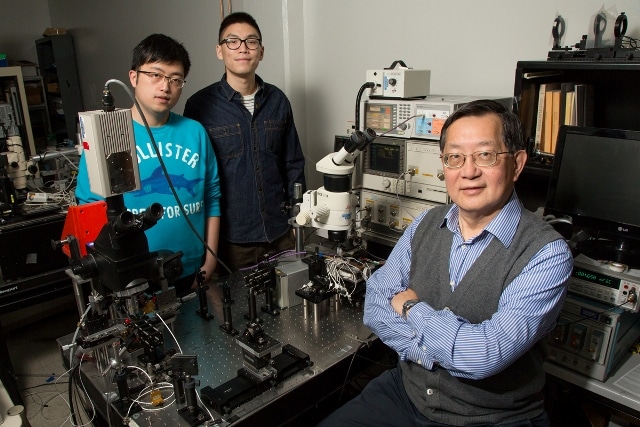Mar 11 2016
Light and electrons interact in a complex dance within fiber optic devices. A new study by University of Illinois engineers found that in the transistor laser, a device for next-generation high-speed computing, the light and electrons spur one another on to faster switching speeds than any devices available.
 Graduate students Junyi Wu and Curtis Wang and professor Milton Feng found that light stimulates switching speed in the transistor laser, a device they hope will usher in the next generation of high-speed data transmission (Photo by L. Brian Stauffer)
Graduate students Junyi Wu and Curtis Wang and professor Milton Feng found that light stimulates switching speed in the transistor laser, a device they hope will usher in the next generation of high-speed data transmission (Photo by L. Brian Stauffer)
Milton Feng, the Nick Holonyak Jr. Emeritus Chair in electrical and computer engineering, found the speed-stimulating effects with graduate students Junyi Qiu and Curtis Wang and Holonyak, the Bardeen Emeritus Chair in electrical and computer engineering and physics. The team published its results in the Journal of Applied Physics.
As big data become bigger and cloud computing becomes more commonplace, the infrastructure for transferring the ever-increasing amounts of data needs to speed up, Feng said. Traditional technologies used for fiber optic cables and high-speed data transmission, such as diode lasers, are reaching the upper end of their switching speeds, Feng said.
“You can compute all you want in a data center. However, you need to take that data in and out of the system for the user to use,” Feng said. “You need to transfer the information for it to be useful, and that goes through these fiber optic interconnects. But there is a fundamental switching limitation of the diode laser used. This technology, the transistor laser, is the next-generation technology, and could be a hundred times faster.”
Diode lasers have two ports: an electrical input and a light output. By contrast, the transistor laser has three ports: an electrical input, and both electrical and light outputs.
The three-port design allows the researchers to harness the intricate physics between electrons and light. For example, the fastest way for current to switch in a semiconductor material is for the electrons to jump between bands in the material in a process called tunneling. Light photons help shuttle the electrons across, a process called photon-assisted tunneling, making the device much faster.
In the latest study, Feng’s group found that not only does photon-assisted tunneling occur in the transistor laser, but that it in turn stimulates the photon absorption process within the laser cavity, making the optical switching in the device even faster and allowing for ultra-high-speed signal modulation.
“The collector can absorb the photon from the laser for very quick tunneling, so that becomes a direct-voltage-modulation scheme, much faster than using current modulation,” Feng said. “We also proved that the stimulated photon-assisted tunneling process is much faster than regular photon-assisted tunneling. Previous engineers could not find this because they did not have the transistor laser. With just a diode laser, you cannot discover this.
“This is not only proving the scientific point, but it’s very useful for high-speed device modulation. We can directly modulate the laser into the femtosecond range. That allows a tremendous amount of energy-efficient data transfer,” Feng said.
The researchers plan to continue to develop the transistor laser and explore its unique physics while also forming industry partnerships to commercialize the technology for energy-efficient big data transfer.
The Air Force Office of Scientific Research supported this work. Feng also is associated with the Micro and Nano Technology Laboratory and the Coordinated Science Laboratory at the U. of I.